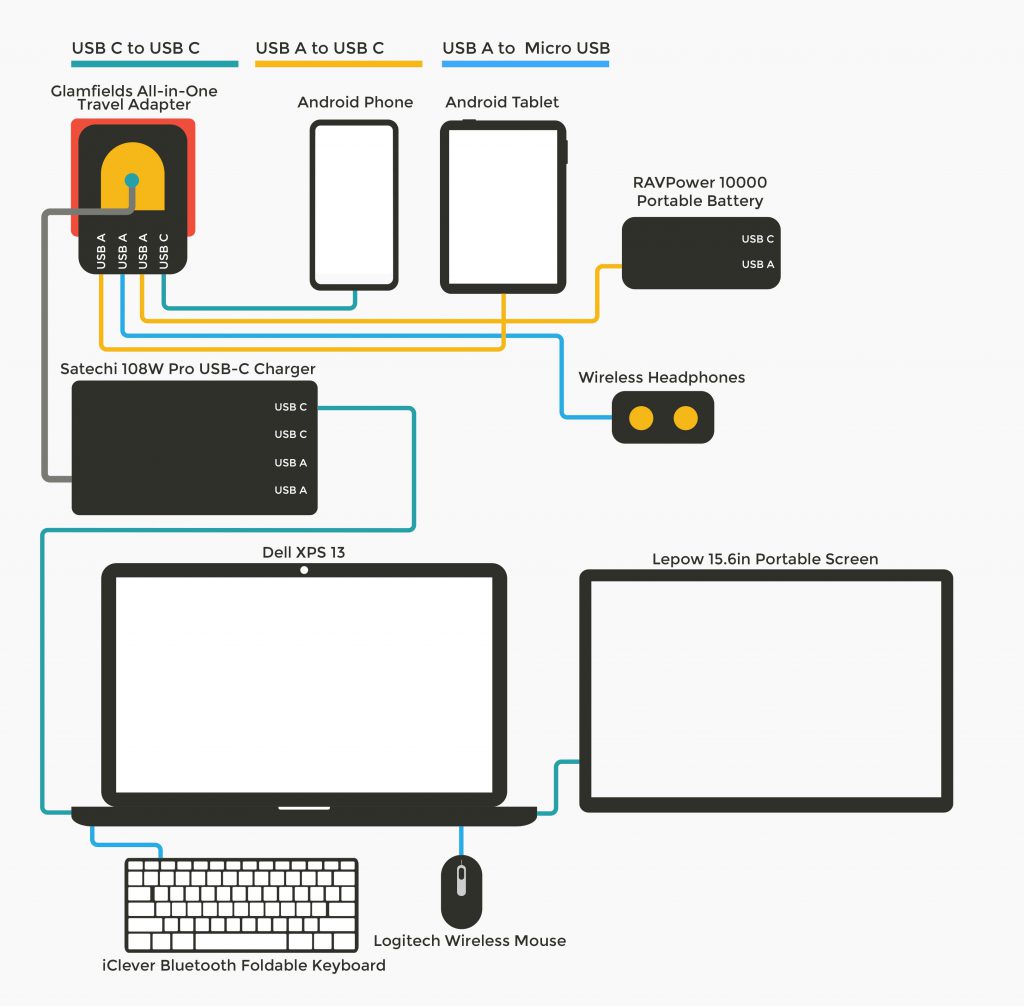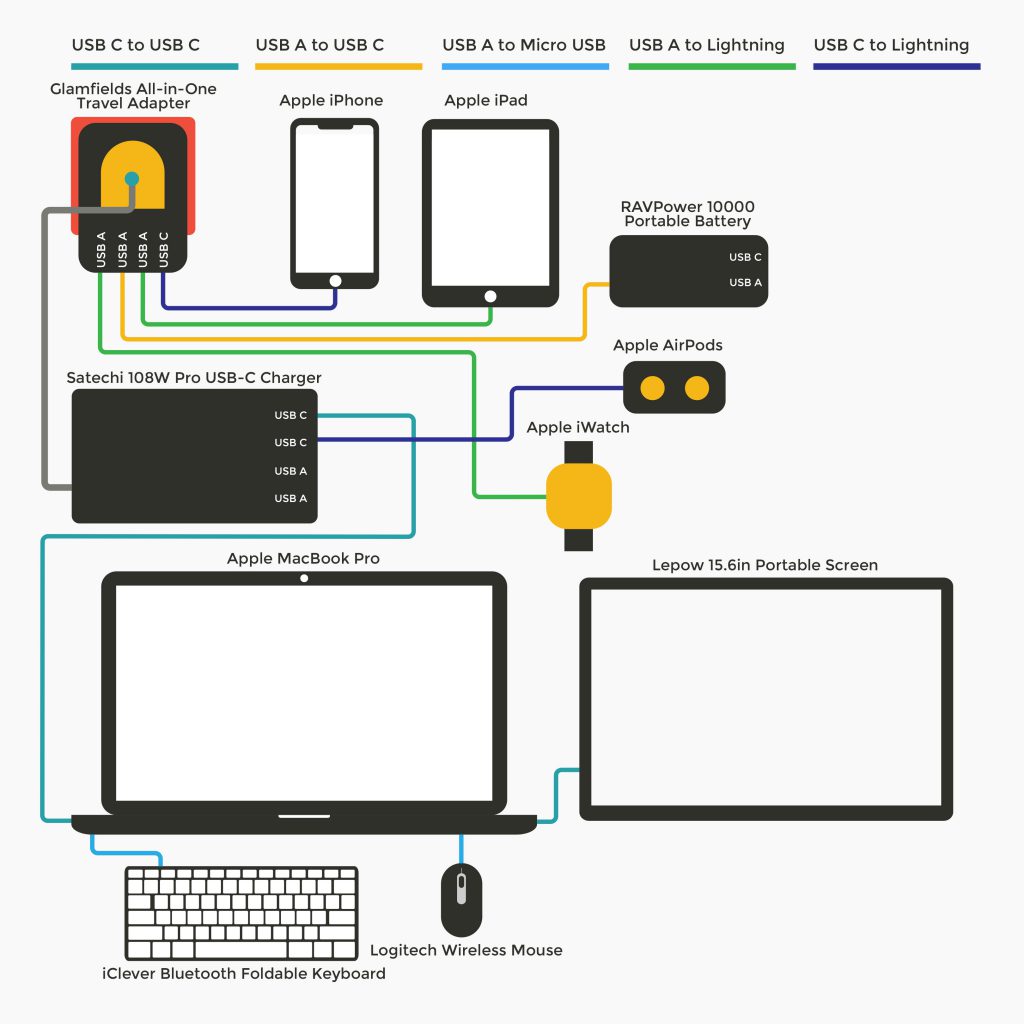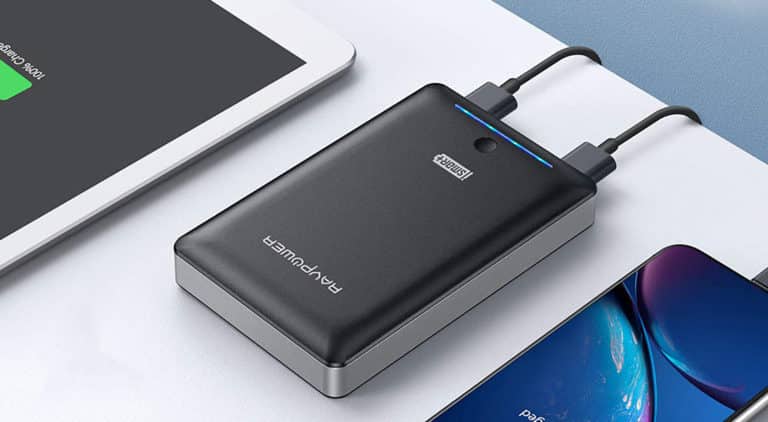The answer to what cables to bring depends of course on what you’re actually bringing. There are lots of variables which play into coming to the correct answer for you. Different devices across manufacturers and age play a big part in what you actually need to bring. I’ll do my best to come to an accurate solution which covers most cases. It’s impossible for me to cover every device possibility out there, but hopefully you come away from this article better informed to make the right decision for you.
First let’s first talk about the types of connections you’ll most likely be dealing with on your devices. USB Type A is the venerable and most recognizable of the bunch. It’s been around a long time and is still the most common connection type you’ll see in chargers. USB Type C is the newest generation that has been becoming more prominent in the last few years. It features the ability to carry more power and you’ll see it used on most new phones and tablets. Micro USB is still very common and used as an end connection in devices such as battery packs, tablets, phones, earbuds and other peripherals. Finally we have Lightning which exists only within Apple phones and tablets, but not laptops. Below you’ll see a visual representation of the connectors we’ll be dealing with.

Cables for Android Travelers
It’s difficult to know how many, and of what type of cables you’ll need, so let’s start with a worst case scenario. Below is what I would consider a fully loaded digital nomad that uses newer Android devices.

It actually looks a little overwhelming when you see it that way doesn’t it? In order to charge all your devices at the same time you would need:
- 3 USB C to USB C (possibly 4)
- 2 USB A to USB C
- 3 USB A to Micro USB
Now it would be awesome if the adapter itself could charge the laptop and skip out on the Satechi charger, but adapters only have enough power to charge low power laptops. If you’re bringing a laptop, you’ll either need to bring its own charger or bring another such as the Satechi. Also, if you are bringing a laptop with an external rechargeable mouse and keyboard, you could get by with one Micro USB cable since these devices rarely need charged. If you aren’t bringing a laptop, things get much more simple. With the Glamfields adapter, you won’t need to bring any other charger bricks and you’ll simply use the USB ports it has.
For Android users I think it’s good to have one of each type of cable. One USB C to USB C, one USB C to USB A, and one USB A to Micro USB. That should have you covered in every instance. Let’s say you just have your phone and a power bank with you. I’d say this is the most common traveling setup. In that case you would just bring the two appropriate cables and the adapter. Easy peasy.
Cables for Apple Travelers

Moving to apple devices now, and you’ll see things get a little more complicated. This is because Apple does not use USB C as extensively as Android devices. Their phones and tablets use Lightning connectors which have USB A and USB C connections on the opposite side. For the diagram above as someone with all Apple devices it breaks down to:
As with the Android devices, if you are not bringing a laptop then you can eliminate the two USB C to USB C cables. If you’re just bringing your iPhone and battery bank, you’ll simply need an USB C to Lightning cable and the appropriate cable for your battery bank along with the adapter. I’d bring along a USB C to USB C and USB A to Micro USB just in case as well. That way you’re covered no matter what happens if you need to buy something new.
And to wrap up, I’ll touch briefly on cable quality. You’ll see wide price differences in cables out there, and that’s because they are different quality. You may think that a cheap one will function well and then eventually break, but it won’t even do that. Cheap cables have weak wiring inside which actually limits how fast your devices can charge. So even if the connections are good, you won’t get 100% of the possible charge rate your device is capable of. That’s why I recommend the JSAUX cables. Not only are they super durable, they have high quality internal copper wiring and chips. It’s really hard to break these things. Anything that is braided will last longer.
Another thing to consider is cable length. Sometimes outlets are far away from where you’d like to sit so having something longer around 6ft(1.8m) is nice to have. But I also like to carry much shorter ones around 1ft(.3m) for use with a battery pack, like these. Think charging in your pocket or day bag, you don’t really want or need a long cable there. So in summary, your devices dictate your cable needs. As a rule you’ll want to have a little redundancy when it comes to cables, don’t be afraid to bring a few extra and have a some options when it comes to length.




